|
Remember,
most images on this site can be enlarged by clicking on them!
|
|
Our
Finch Diet
Water
| Seed/Pellets | Calcium
Sources | Eggfood | Fruits/Vegetables/Greens
| Treat | Millet
Spray | Vitamin Supplements
| Water |
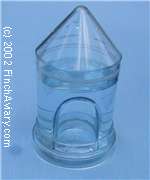 |
Clean
filtered water is always available to our birds. We change
the water at least once a day to keep bacteria from spreading.
I avoid tap water because of some of the chemicals added
to make it safe for human consumption. We use a water filter
to remove these chemicals. Alternatively, bottled water
or distilled water can be offered. I've heard that letting
tap water sit out for 24 hours allows the chlorine to escape,
making the water safer for pets, so this option might be
used when other alternatives are not available or affordable. |
| |
| Seed/Pellets |
 |
| E.M.
Spec Finch Mix from
Herman Bros.
Seed. |
 |
| Lafeber's
Granular Finch Diet |
| |
Okay,
maybe I came down on seeds a little hard. Seed is not
bad. Seed is, in fact, the staple of our birds' diet.
It is just not a complete, well-balanced diet by itself.
Fresh
seed is important. Fresh seed is hard to find in a pet
store. Sometimes, their seed doesn't sell very fast and
ends up sitting on the shelves for a long period of time.
Don't even think about how long it took to get the seed
to the store in the first place. You can find out if the
seed is fresh by testing how well it sprouts. Of course,
if you've never seen how easily fresh seed sprouts, this
may be difficult to judge. If it doesn't sprout at all
- pitch it! There is very little nutritional content left.
In
addition, pet stores tend to sell finch seed in small,
expensive, 2 lb bags. Perhaps they reason that small birds
don't eat a lot, therefore people don't need a lot. This
may be true for many finch owners, but at the same time,
many finch owners own more than a just a pair or two.
When you have many finches, a 2 lb bag won't last long.
You can get commercial seed mixes in bulk from some online
bird supply stores if you want to save a little money
(although shipping will drive the price up quite a bit,
it still almost certainly will be cheaper than buying
many small bags from a pet store). Seed can be purchased
in bulk from Hornbeck's
(now owned by Drs. Foster and Smith), among other
places.
We
now order our seed directly through a seed supplier. We
order E&M spec Finch Mix from Herman
Bros Seed. This seed is so fresh that I once accidentally
spilled some seed in the pan beneath the grate of a quarantine
cage - it got wet, and before I knew it, I had sprouts
growing right there. After struggling to sprout a commercial
seed mixture, I was amazed to see this seed sprout accidentally
and so quickly. I would never go back to a commercial
mixture. The price, even after shipping, is also much
more affordable than the commercial seed. Unfortunately,
Herman Bros does not have an online order form.
I
usually buy enough seed to last me somewhere between 1
and 2 months so that it doesn't lose its freshness. Seed
can also be frozen if you would like to keep it for longer
periods.
When
we switched to the E&M spec finch mix, we added Lafeber
finch diet granules on the side (to compensate for the
absence of the pellets that fortified the commercial mix
we had been feeding before). Not all my birds like the
granules, but some do, and I believe they benefit from
the added nutrients they provide, even if only eaten on
a supplementary basis. Lafeber finch diet can be purchased
from most pet stores and can also be purchased in bulk
from Hornbeck's
(now owned by Drs. Foster and Smith). Some people
convert their birds over from seed to a strictly pellet-based
diet because it is supposed to be more balanced than seed,
but this can be a difficult task. My birds enjoy seed
so much, I don't want to take it away from them.
Don't
think that by converting a bird from seed to pellets you
no longer have to offer fresh foods. Yes, pellets tend
to be fortified with the vitamins and minerals that some
experts guess constitute a well-balanced avian diet. But
taking a vitamin supplement has never replaced a balanced
meal for humans, and your birds are no different.
Never
feed your birds the bird seed meant for wild birds, even
if it is especially blended for finches. There is a very
wide range in the quality of wild bird seed -- much of
which is at the low end of the quality scale. Even the
high-quality wild bird seed is not appropriate for birds
kept indoors. Outdoor birds have different needs. They
are exposed to greater temperature differences and they
have unlimited open space for exercise and flight. Therefore,
wild bird seed mixes are frequently higher in fat content
than mixes blended for pet birds. The fat content does
not adversely affect the outdoor birds because they need
more fat to stay warm in cold temperatures and they have
the open space to exercise and burn off the fat.
Even
if you keep your birds in an outdoor aviary, I still would
recommend a seed mix specially blended for pet birds unless
you are certain of the quality of the outdoor seed. My
advice: Feed the wild birds the wild seed mix. Feed your
own birds the pet bird seed mix. Everybody wins.
|
| |
|
|
 |
Crushed
oyster shell - the product sold by Hagen is pictured
|
|
|
Female
blue cap replenishes her calcium supply with some
tasty oyster shell - yum!
|
 |
| Cuttlebone |
| |
Calcium
is a nutrient that figures heavily into a bird's diet.
It is especially important for egg-laying females. Hens
can quickly deplete their calcium supply when producing
eggs. Without an adequate source of calcium, they may
become egg bound, which can be fatal if the hen is unable
to expel the egg. But don't think that if you don't keep
females that you don't have to worry about calcium intake.
We frequently catch the male zebras pecking at the cuttlebone,
and I have to believe that some nutritional need drives
this behavior.
Calcium
can be found in many green leafy vegetables. For example,
turnip greens, mustard greens, and dandelion greens are
all good sources of calcium (see Fruits,
Vegetables, and Greens).
In
addition to the calcium found in vegetables, we supplement
our birds' calcium intake with crushed oyster shell and
cuttlebone, which we make available at all times. Cuttlebone
can be found at any pet store. Some pet stores also carry
crushed oyster shell (8 in 1 and Hagen have crushed oyster
shell products), but if you can't find it locally, oyster
shell is also available from Birds2Grow.
When
available, I supply crushed eggshells for additional calcium.
To prepare the eggshells, I rinse them thoroughly, then
I microwave them. I heat one or two eggshells on high
for 1.5 to 2 minutes. If I have a dozen or so, I microwave
them longer (maybe 3 or 4 minutes). If they turn brown
and start to smell like burnt popcorn, I've heated them
too long. The important thing is that they come out dry,
because the bacteria live in the moisture. I then break
up the eggshells into small pieces and serve to the birds
as is or mixed in with their eggfood.
In
emergencies, I keep some Calciboost liquid calcium on
hand. I've never needed to use it, but I've heard it can
be quite effective in assisting an egg-bound hen to expel
the troublesome egg. Although calcium at this stage can
do nothing to improve the quality of the eggshell, Birds2Grow
had reported it to have an effect on the muscle activity
needed to expel the eggs. That article has since been
moved or removed from their site.
|
|
| Eggfood |
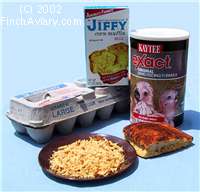 |
| Egg
Bread Ingredients and the final product. |
| |
I
believe eggfood is one of the most important elements
of the birds' diet. It provides the added protein they
might not get otherwise (unless being fed a diet consisting
largely of live food). I offer eggfood every day, although
many people offer it every other day or a couple of times
a week.
There
are many different recipes for eggfood, some very simple,
some more elaborate. You can get as fancy as you like.
The simplest recipe consists of hard-boiled egg, mashed
with a fork, shell and all, and served to the birds. This
is a good place to start if you don't want to spend a
lot of time researching or preparing recipes (or trying
to find some of the exotic ingredients that can be added).
Sometimes
it may take a little patience if the birds are not used
to eggfood provided in this manner. Some birds do not
like the wet, mushy texture. Because of this, many finch
keepers add ingredients such as bread crumbs or dry handfeeding
formula to the egg food to make it drier and crumbly.
If
your birds don't take to hard-boiled egg or if you are
concerned about spoilage, you can try serving eggfood
in the form of egg bread. My recipe was adapted from a
simple recipe posted many times by a man named Joe who
used to answer questions on the now defunct Finch Network
message board. The recipe involves mixing a dozen eggs
with a cornbread mix and baking. See Eggfood
Recipes for details. Ideally, I believe a hard-boiled
egg recipe is preferred because you don't have the added
carbohydrates contributed by the cornbread mix, but I've
found that my birds universally accept the egg bread recipe
and take to it much quicker than hard-boiled eggfood.
In addition, because this product has a dry muffin-like
texture, the crumbs dry out rather than spoil as might
sometimes happen with hard-boiled egg recipes, making
it ideal for those who are not home to remove the eggfood
after a few hours.
Many
people add vitamin supplements to their eggfood. I add
a touch of Nekton-Bio to mine. Many avian vitamins are
available at Hornbeck's
(Drs. Foster and Smith) and Birds2Grow,
but some may also be available at petstores.
Other
ingredients people have added to their eggfood include
game bird mash, crushed dog or cat food, and diced vegetables.
|
| |
| Fruits,
Vegetables, and Greens |
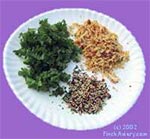 |
A
Typical Fresh Food Plate
The Green of the Day: Mustard Greens
|
 |
| As
soon as the plate hits the floor, birds come diving
in to check out today's menu: eggbread, turnip greens,
and some treat. |
| |
I've
never been successful at adding fruits to my birds' diet.
There has been the rare occasion when they've picked at
an apple wedge, but other than that, no luck. I've finally
given up, in the belief that fruit is not all that necessary.
I
offer one type of vegetable or green a day. I used to
offer a smorgasbord, but I noticed that many birds would
stick to their favorite veggie in the mix and not get
the balanced diet I was trying to provide. I therefore
only offer one veggie a day and I can be more assured
that they are getting a little of everything. The following
are the vegetables I have chosen to offer to my birds:
Romaine Lettuce (not the most nutritious choice, but better
than iceberg lettuce and a favorite among my birds), Carrot
Greens, Turnip Greens, Curly Mustard Greens, Kale, Broccoli,
Spinach (no more than once a week because it is high in
oxalic acid), Green beans (sliced lengthwise with a potato
peeler), corn, and Dandelion Greens.
When
I serve greens and vegetables, I slice them up into small
pieces. If I offer whole leaves, someone (frequently my
canary) absconds with the entire leaf. I cannot clip leaves
to the aviary, either, since the button quails who reside
on the bottom would not have access. A salad-style presentation
makes it easier when you have a number of birds sharing
the meal.
Vegetables
can be an excellent source of two nutrients critical to
bird health: calcium and vitamin A. The following veggies
are some good sources of both: Mustard Greens, Turnip
Greens, Dandelion Greens, Collard Greens, Kale, and Broccoli
Leaves.
|
| |
| Treat |
 |
| Varieties
of Kaytee treat |
| |
I
offer a small amount of Kaytee treat for finches. I started
doing this to attract the birds to the food plate and
to entice them to try the other selections, but I've kept
it up because they seem to like it. The treat does include
dyed pellets, which I am not crazy about, but I only offer
this in limited quantities, so I let it slide. Treat should
not take the place of a good finch seed mix.
|
| Millet
Spray |
 |
| Millet
on the spray |
 |
| 5
lb box of millet from Herman Bros. Seed. |
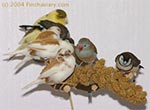 |
| The
birds flock to the millet as soon as it is offered. |
| |
Millet sprays are bird candy. If you offer it ad libitum,
they will eat it all day long. I offer sprays once a week,
after I've finished my weekly aviary cleaning. It is their
reward for putting up with me intruding on their space.
I
get my millet spray from Herman
Bros Seed. Their 5 lb box is $12.75 (at the time of
this writing) and contains almost 100 long fat sprays
full of fresh millet seeds. This is cheaper and better
than the millet you can get from the petstore.
I
highly recommend finding a source of fresh millet sprays.
I've been very disappointed with the quality of commercially
sold millet sprays available at pet stores. These sprays
tend to be thin, dry, and likely quite old.
|
| |
| Vitamin
Supplements |
 |
| Nekton-Bio
(left) and Nekton-S (right) vitamin supplements. |
| |
The need for vitamin and mineral supplements is highly
debated. Many people believe that a varied diet will provide
the bird with all the nutrients that they need. Others
believe most birds do not get offered or do not accept
a balanced enough diet and vitamin supplementation should
be used to make sure they get it. Whatever the case, vitamins
should not be used in place of fresh food, but only as
a supplement in case something is still missing in their
diet.
There
are different types of vitamins. Some are meant to be
mixed in soft food like eggfood, others are meant to be
mixed in the water, and some can be mixed with either.
It is not a good idea to add vitamins to the seed because
they do not stick very well to dry food. Most importantly,
the birds husk the shells anyway, so it is questionable
as to how much of the supplement will actually be ingested.
When
vitamins are added to the water, you can be sure your
birds are taking it in, since they must drink the water
to survive. But the vitamins can add an unwanted taste
to the water and they also can promote bacteria.
When
vitamins are added to soft foods, you can never be sure
if all the birds are eating it or eating enough of it
to benefit from it. However, since my philosophy is that
the vitamins are nothing more than a safety net (just
in case), I don't worry too much about the birds not getting
enough. Some is probably better than none.
As
stated above, I currently add Nekton-Bio to my eggbread.
I follow the instructions supplied in the bottle regarding
dosage and I haven't noticed anyone refusing the egg bread
because of the included vitamins
|
Click
Previous to return to the Balanced Diet page | Click Next to
read about Other Food Sources
PREVIOUS  |
|  NEXT
NEXT
 TOP TOP
|
|
|
How
do you care for your birds?

Vote
in our survey or view the results!
|
|
| |
See
Also:
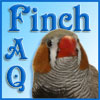
For answers to some
commonly asked questions!
|
|
|
















